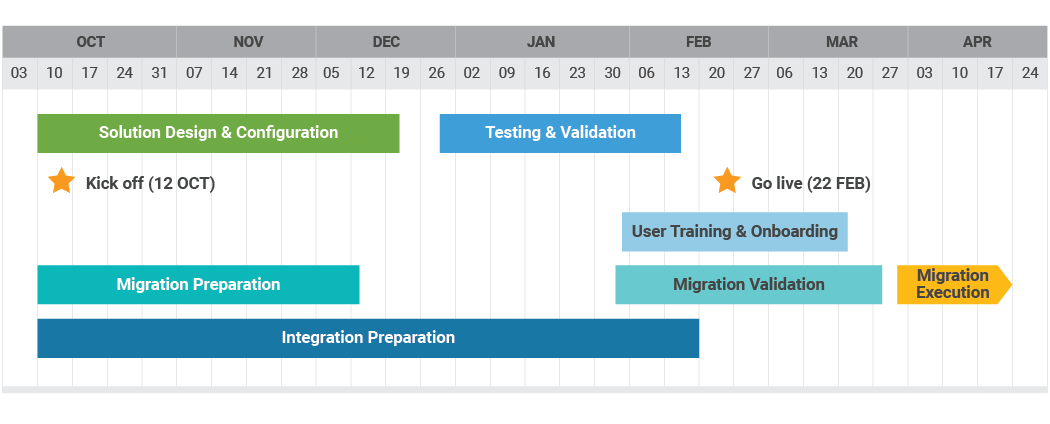Smith+Nephew Improves Data Quality and Governance with Migration Preparation
Preparing for data migration to improve data quality and governance
- Headquarters: Watford, England
- Founded: 1856
- Number of Employees: 19,000+
- Countries Served: 100
- Solutions: Veeva Clinical Operations Platform
During Veeva MedTech Summit in Europe, Lois Spencer, IT transformation lead at Smith+Nephew, shared how the company transitioned to a cloud-based eTMF solution and maintained data integrity throughout the migration process.
Making the decision to migrate to an eTMF
Prior to their migration to Veeva eTMF Smith+Nephew managed clinical studies predominantly through manual processes and relied on third parties to assist with study builds, which resulted in lower internal adoption rates than expected. Spencer says, “We manage over 70 studies across 400 sites and the process was quite complex. Our systems were completely separate from one another and it was an Excel-based process with a 3rd party to be able to perform a study setup. Because of these manual and tedious activities and the TMF being a legacy piece of software, we selected Veeva to reduce chaos and streamline everything through an eTMF.”
In addition to implementing Veeva eTMF, Spencer continues, “There was no connection to our CTMS and we sometimes required 2-3 days for our studies and often saw backlogs of documents, which caused stress for our clinical team around internal audits and inspections.”
During the implementation, Smith+Nephew partnered closely with the Veeva MedTech Business Consulting team to create a migration timeline and revise their existing processes to ensure audit readiness.
“We manage over 70 studies across 400 sites and the process was quite complex . . .We selected Veeva to reduce chaos and streamlining everything through an eTMF.” – Lois Spencer, IT transformation lead at Smith+Nephew
Implementing eTMF and developing good practices
Spencer highlighted the importance of taking a phased approach and involving stakeholders from Smith+Nephew and Veeva to help establish good Vault practices. Spencer wanted to start with an out-of-the-box solution and “work with the Veeva implementation team to conduct iterative solution reviews. [Smith+Nephew] was able to build studies in a real-time environment and then make tweaks and changes to processes after seeing the functionality. Having that visual playback made it easier for stakeholders to see what the end result of a new solution would look like”. From a technology standpoint, Spencer was pleased to see that data and information were preconfigured, which made it easier to adapt to their business processes.
Since launching Veeva Veeva eTMF, Spencer noted improvements in their ability to create study sites independently, upload and reduce duplicate documents with the help of TMF Bot, and consolidate the QC and filing process. By unifying their eTMF and CTMS solutions, Smith+Nephew increased visibility into KPIs to help study managers make data-driven decisions and establish transparency with senior leadership.
Understanding data for a successful migration

During implementation, Spencer noted some challenges in successfully migrating data from their legacy systems. Prior to conducting the data migration, Spencer emphasized that, “Smith+Nephew took an iterative approach, moving in sprints, to ensure data integrity. First, we conducted design and configuration workshops with Veeva, followed by dry runs to test the quality of our data, and then trained our team ahead of our go-live date.”
Spencer continues, “[Smith+Nephew] leveraged a bespoke piece of middleware to conduct the data migration process from our legacy systems, which forced us to defer our data migration to after implementation.” This delay put pressure on the timeline as they needed to retain audit history across 25 studies and 25,000 documents.
In order to ensure data integrity during the migration, Smith+Nephew split the migration into waves. Spencer says, “Managing the timeline required upfront planning and execution. We established core priorities, beginning with getting eTMF live first. The implementation happened quickly and we were pleased with the quality and standard that came through in the configuration. We were then able to focus on data quality and governance, which required careful collaboration with the Veeva team to help us stay true to our timeline.” Taking a phased approach and working closely with Veeva Business Consulting allowed Smith+Nephew to cleanse the data and have a successful migration in accordance with their timeline.
Lessons Learned
- 1. Conduct Vault admin training – Choosing to participate in a two week intensive training ahead of an implementation will help establish autonomy and gain a better understanding of how things
operate on the backend. This was instrumental in preparing for all aspects of implementation, particularly data migration.
- 2. Incorporate dry runs – Ensure sufficient time is allocated for dry runs to validate system requirements and data quality. This supports a smooth transition into production.
- 3. Partner closely with IT – Having open communication with IT to establish appropriate timelines
in accordance with project milestones enabled Smith+Nephew to plan for technology requirements ahead of the data migration process, which eliminated unnecessary downtime.
- 4. Evaluate data transformation requirements – Cleansing data upfront not only saved time, but also
allowed them to accurately map data to the right elements when performing migration. This helped maintain data quality and integrity.
Hear how Smith+Nephew is integrating clinical workflows in a single platform.